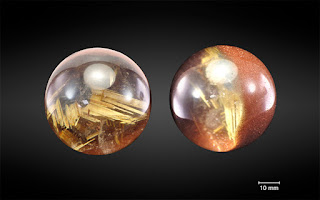P.J.Joseph's Weblog On Colored Stones, Diamonds, Gem Identification, Synthetics, Treatments, Imitations, Pearls, Organic Gems, Gem And Jewelry Enterprises, Gem Markets, Watches, Gem History, Books, Comics, Cryptocurrency, Designs, Films, Flowers, Wine, Tea, Coffee, Chocolate, Graphic Novels, New Business Models, Technology, Artificial Intelligence, Robotics, Energy, Education, Environment, Music, Art, Commodities, Travel, Photography, Antiques, Watches, Random Thoughts, and Things He Like.
Translate
Monday, February 12, 2024
Rare Natural Bicolor Diamond
Tuesday, March 01, 2022
Two Antique Mughal Spectacles With Gemstone Lenses
Truly unique antique spectacles. Many thanks to GIA New York Lab for sharing the info. Must read.
Friday, September 24, 2021
Chrysoberyl Inclusions In Flux-Grown Ruby
Gemologists, gem dealers, consumers beware. Today microscope is not enough. You need LA-ICP-MS and Raman spectroscopy to assist positive gem identification. Many gem testing labs can't afford expensive analytical gem testing instruments. Ask questions if you are doubtful.
Sunday, April 18, 2021
Unusual Absorption In A Blue Flux-Grown Synthetic Sapphire
With UV-Vis-NIR spectroscopy, GIA researchers were able to identify the unusual spectrum. It has never been reported in blue lab-grown sapphire, either flame-fusion or flux-grown. Practicing gemologists should take note.
Large Type IIa Diamond From Arkansas, USA
With FTIR, GIA researchers were able to identify the diamond as type IIa with no measurable nitrogen impurities. Type IIa diamonds are extremely rare among natural diamonds, especially from a source in the United States. A collector's diamond indeed.
Sunday, April 11, 2021
Spectral Analysis Of Resin Imitation Ivory
Without FTIR, Raman spectroscopy, and reference samples, separating ivory from resins would be difficult.
Tuesday, February 02, 2021
Dramatic Color Zoning In Alexandrite
Alexandrite's color looks red in incandescent light and green in fluorescent light or daylight. But gem cutters could modify crown and pavilion facets due to the size and shape of the rough. The result can be different. Take a look.
Synthetic Moissanite With Fraudulent GIA Inscription
Buyer beware. If doubtful, always consult a reputed gem testing laboratory like the GIA.
Monday, February 01, 2021
A Near-Field-Communication Technology Device Embedded In Bead Cultured Pearls
Since cultured pearls are opaque, the implementation of such micro-technologies within them is a viable option for a specific function. Analytical gem testing instruments such as optical X-ray fluorescence imaging, EDXRF analysis, real-time microradiography, laser ablation-inductively coupled plasma-mass spectrometry may be required for in-depth analysis. The GIA research report is a must read.
Saturday, January 30, 2021
A New Type Of Rutilated Quartz Composite Product
Novelty Cut Diamond With Remarkable Fire And Ice Fluorescence
I haven't seen this phenomenon before. The fancy yellowish brown contained a remarkable hydrogen cloud in the blade and cape features in the hilt. The stone showed corresponding areas of yellow and blue fluorescence in long-wave UV light. The cutting style of this diamond, while unconventional, served to showcase the remarkable fluorescence scene illuminated within. The fluorescence differences allow this diamond to be imagine as a lightsaber or a sword of fire and ice. Many thanks to GIA Carlsbad Laboratory for Color Origin and Identification Service.
Friday, January 29, 2021
Magnetite Inclusions In Star Peridot
The rectangular needle-like magnetite inclusions are responsible for the four-rayed asterism in star peridot. Take a look.
Black Star Sapphire With Dual Treatments
In Thailand, glass and dopping varnish is commonly used to treat black star sapphires for variety of reasons. Buyer beware. If in doubt, always consult a reputable gem testing laboratory.
Thursday, January 28, 2021
Blue Spodumene
The main source of gem quality spodumene is Afghanistan; other sources are Pakistan, Brazil, Madagascar, Mozambique, and the United States. While it is unknown whether the color of this blue spodumene was of natural or artificial origin, such stones are rarely seen as faceted gems, and this unusual large example would be of interest to any gem collector. Blue spodumene can easily be confused with aquamarine.
Pearl Discovered In Edible Oyster From The Ostreidae Family
This is the first examination by GIA gemologists of a pearl known to have been produced from the Ostreidae family (true oyster) mollusk, as well as the first GIA identification report for one. The significant size and weight of this 15.53 carat pearl are noteworthy. Take a look.
Thursday, December 03, 2020
Friday, November 06, 2020
Unusually Shaped Rutile Crystal Inclusions In Russian Emerald
GIA Lab Notes. Take a look at the unusual gem inclusions in emerald.
Thursday, November 05, 2020
Windmills In Rare Mineral Sphalerite
GIA Lab Notes. Take a look at the propeller-like gem inclusions in Sphalerite.
Trapiche-Like Pattern In An Emerald From Pakistan
GIA Lab Notes. A wonderful pattern of gem inclusions rarely seen in emeralds.
Useful link: https://www.gia.edu/gems-gemology/summer-2020-microworld-trapiche-like-pattern
Wednesday, November 04, 2020
Cat’s-Eye Andradite
GIA Lab Notes. This optical phenomenon is common in many gemstone species, and the demantoid variety of andradite garnet has been known to display cat's eye-like effect.























